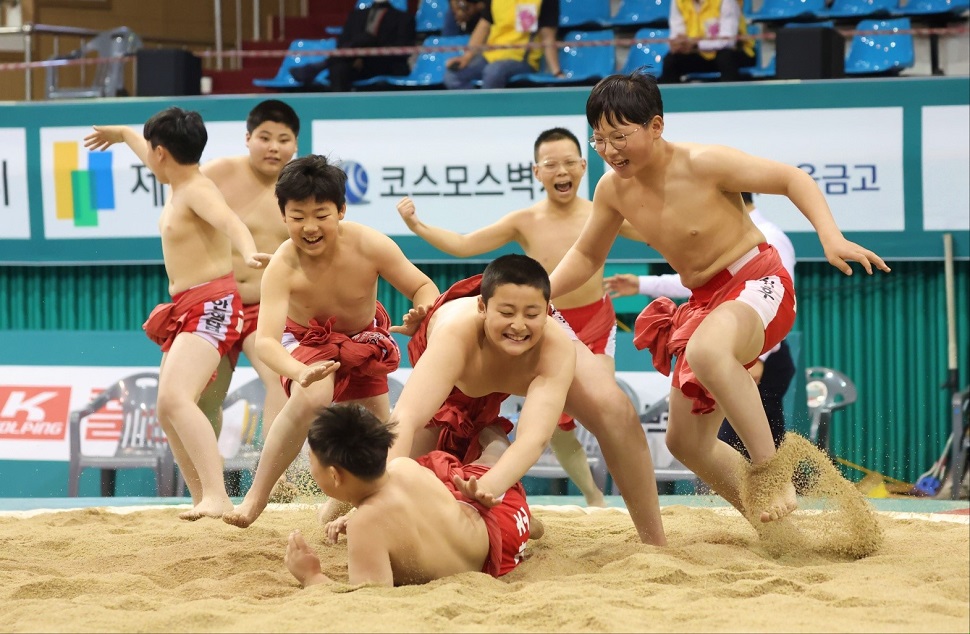[May] Ssireum: traditional Korean wrestling promotes solidarity
Date May 18, 2023
 Students from Gyobang Elementary School in Changwon, Gyeongsangnam-do Province, celebrate after winning the group elementary school division tournament of The 1st Korean Sport & Olympic Committee President Cup: National Jangsa Ssireum Competition in Boseong, Jeollanam-do Province. The competition took place from April 30 to May 6. (Courtesy of Korea Ssireum Association)
Students from Gyobang Elementary School in Changwon, Gyeongsangnam-do Province, celebrate after winning the group elementary school division tournament of The 1st Korean Sport & Olympic Committee President Cup: National Jangsa Ssireum Competition in Boseong, Jeollanam-do Province. The competition took place from April 30 to May 6. (Courtesy of Korea Ssireum Association)
The global popularity of Korean reality shows like “Physical: 100” – a Netflix program in which 100 participants in top physical shape vie against one another – has piqued people’s interest in Korea’s different sports activities. For many of them, taekwondo or Korean martial arts may be the first thing that comes to their mind when thinking of Korean sports. However, the country has another national sport that is as historical and valuable – ssireum.
Ssireum is a type of wrestling in which opponents grip the other’s satba – a cloth strap tied around the waist and right thigh – and try to force the competitor to the ground. They can employ different techniques using their hands, legs and feet, among others. The final winner or jangsa receives an ox trophy as a prize, emblematic of the coveted live ox prize given when Korea was an agrarian society.
The oldest records of ssireum in Korean history date back to the Three Kingdoms Era (57 BCE-668 CE). Murals in Goguryeo tombs show ssireum as part of people’s daily lives in ancient times.
In 1912, the Yugakkwon Club – also known as Yugakkwon Gurakbu – hosted the first ssireum competition in Seoul with rules similar to those followed today. At the 12th National Ssireum Championship Contest in 1956, wrestlers were grouped into weight classes for the first time. Though only separated into two groups in the beginning, they follow a seven-tier system today. Some of the biggest competitions these days include the National Ssireum Championship Contest and the President’s Cup National Jangsa Ssireum Contest.
Ssireum matches are held on traditional holidays and other occasions. Matches frequently occur on Dano, a Korean holiday on the fifth day of the fifth lunar month. In 2012, Dano was designated “Ssireum Day.”
In 2018, ssireum was inscribed on the UNESCO Intangible Cultural Heritage list after North and South Korea made their first-ever joint bid.
“Ssireum games take place on sand in any available space in a neighborhood, and are open to community members of all ages, from children to seniors,” reads UNESCO’s introduction to ssireum. “Different regions have developed variants of ssireum based on their specific backgrounds, but they all share the common social function of ssireum – enhancing community solidarity and collaboration. As an approachable sport involving little risk of injury, ssireum also offers a means of improving mental and physical health.”
Numerous regions in Korea organize ssireum tournaments. Most recently, the Korea Ssireum Association hosted “The 1st Korean Sport & Olympic Committee President Cup: National Jangsa Ssireum Competition” in Boseong, Jeollanam-do Province, from April 30 to May 6. More than 932 athletes took part in the competition, which was held to spread awareness of ssireum while promoting the Boseong World Tea EXPO. The EXPO took place from April 29 to May 7.
One of the most famous ssireum players in Korea is Kang Ho-dong, who is now a TV host and comedian. Prior to making a foray into the showbiz industry, Kang won the 44th National Ssireum Championship in 1989 after beating the legendary Lee Man-gi. The talented Kang continued his winning streak for several years, clinching the Cheonhajangsa Ssireum Championship – one of the biggest ssireum tournaments in Korea that took place from 1983 to 2004 – five times. He is the youngest-ever Cheonhajangsa title holder, who pulled off the feat at the age of 19. He retired from ssireum in 1992.

The Ministry of Culture, Sports and Tourism's "Korea Here & Now" work can be used under the condition of "Public Nuri Type 1 (Source Indication)."




